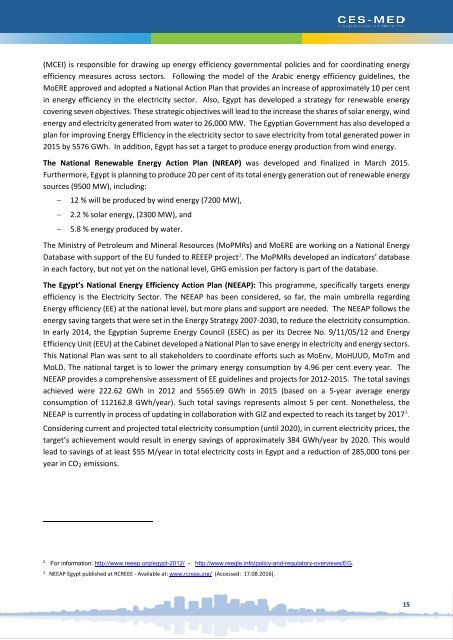130218_Luxor-Egypt SECAP Final
You also want an ePaper? Increase the reach of your titles
YUMPU automatically turns print PDFs into web optimized ePapers that Google loves.
(MCEI) is responsible for drawing up energy efficiency governmental policies and for coordinating energy<br />
efficiency measures across sectors. Following the model of the Arabic energy efficiency guidelines, the<br />
MoERE approved and adopted a National Action Plan that provides an increase of approximately 10 per cent<br />
in energy efficiency in the electricity sector. Also, <strong>Egypt</strong> has developed a strategy for renewable energy<br />
covering seven objectives. These strategic objectives will lead to the increase the shares of solar energy, wind<br />
energy and electricity generated from water to 26,000 MW. The <strong>Egypt</strong>ian Government has also developed a<br />
plan for improving Energy Efficiency in the electricity sector to save electricity from total generated power in<br />
2015 by 5576 GWh. In addition, <strong>Egypt</strong> has set a target to produce energy production from wind energy.<br />
The National Renewable Energy Action Plan (NREAP) was developed and finalized in March 2015.<br />
Furthermore, <strong>Egypt</strong> is planning to produce 20 per cent of its total energy generation out of renewable energy<br />
sources (9500 MW), including:<br />
− 12 % will be produced by wind energy (7200 MW),<br />
−<br />
−<br />
2.2 % solar energy, (2300 MW), and<br />
5.8 % energy produced by water.<br />
The Ministry of Petroleum and Mineral Resources (MoPMRs) and MoERE are working on a National Energy<br />
Database with support of the EU funded to REEEP project 2 . The MoPMRs developed an indicators’ database<br />
in each factory, but not yet on the national level, GHG emission per factory is part of the database.<br />
The <strong>Egypt</strong>’s National Energy Efficiency Action Plan (NEEAP): This programme, specifically targets energy<br />
efficiency is the Electricity Sector. The NEEAP has been considered, so far, the main umbrella regarding<br />
Energy efficiency (EE) at the national level, but more plans and support are needed. The NEEAP follows the<br />
energy saving targets that were set in the Energy Strategy 2007-2030, to reduce the electricity consumption.<br />
In early 2014, the <strong>Egypt</strong>ian Supreme Energy Council (ESEC) as per its Decree No. 9/11/05/12 and Energy<br />
Efficiency Unit (EEU) at the Cabinet developed a National Plan to save energy in electricity and energy sectors.<br />
This National Plan was sent to all stakeholders to coordinate efforts such as MoEnv, MoHUUD, MoTm and<br />
MoLD. The national target is to lower the primary energy consumption by 4.96 per cent every year. The<br />
NEEAP provides a comprehensive assessment of EE guidelines and projects for 2012-2015. The total savings<br />
achieved were 222.62 GWh in 2012 and 5565.69 GWh in 2015 (based on a 5-year average energy<br />
consumption of 112162.8 GWh/year). Such total savings represents almost 5 per cent. Nonetheless, the<br />
NEEAP is currently in process of updating in collaboration with GIZ and expected to reach its target by 2017 3 .<br />
Considering current and projected total electricity consumption (until 2020), in current electricity prices, the<br />
target’s achievement would result in energy savings of approximately 384 GWh/year by 2020. This would<br />
lead to savings of at least $55 M/year in total electricity costs in <strong>Egypt</strong> and a reduction of 285,000 tons per<br />
year in CO 2 emissions.<br />
2<br />
For information: http://www.reeep.org/egypt-2012/ - http://www.reegle.info/policy-and-regulatory-overviews/EG.<br />
3<br />
NEEAP <strong>Egypt</strong> published at RCREEE - Available at: www.rcreee.org/ (Accessed: 17.08.2016).<br />
15

















